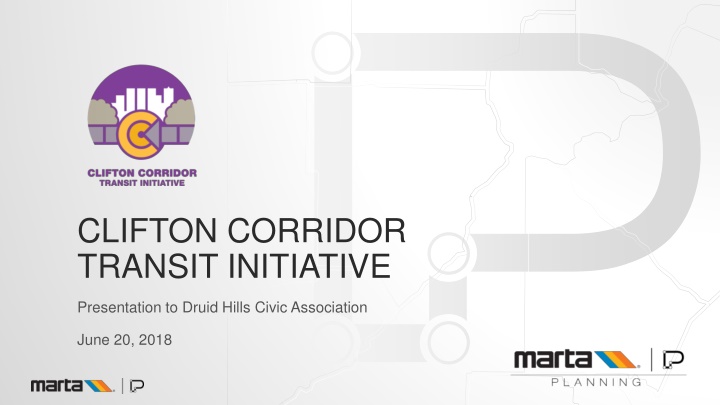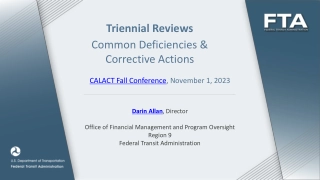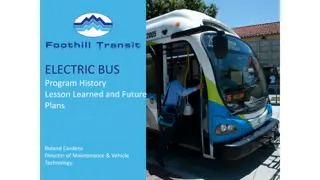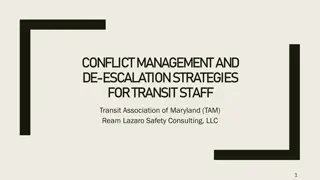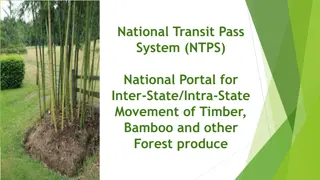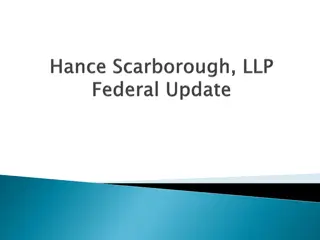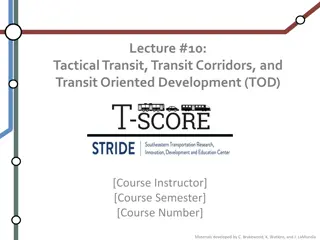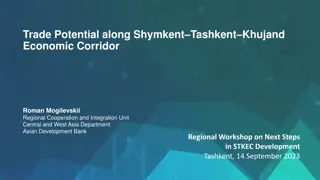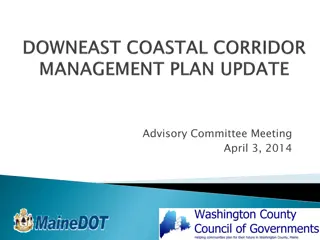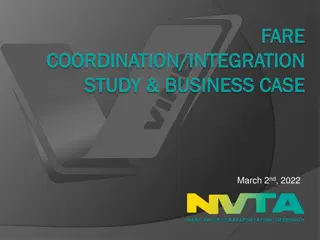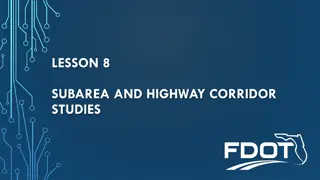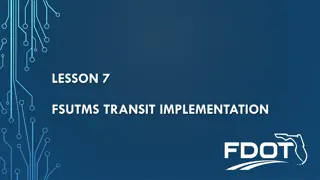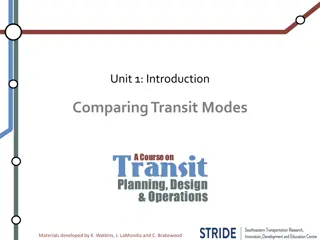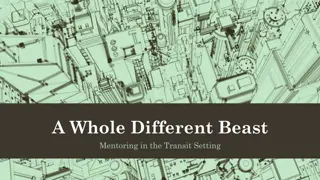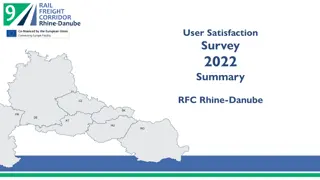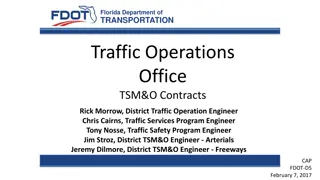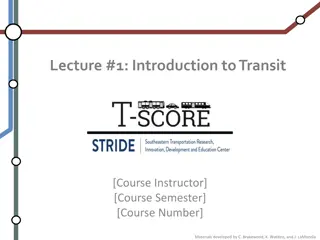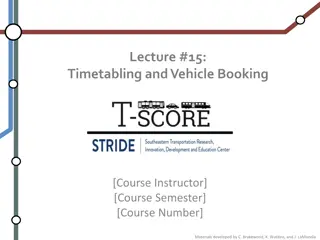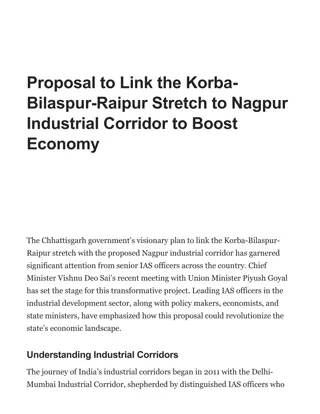Clifton Corridor Transit Initiative Presentation
This presentation highlights the Clifton Corridor Transit Initiative to the Druid Hills Civic Association, discussing the project background, current status, next steps, neighborhood context, and regional transit importance. It also explains light rail transit, project history, and the milestones achieved so far.
Download Presentation

Please find below an Image/Link to download the presentation.
The content on the website is provided AS IS for your information and personal use only. It may not be sold, licensed, or shared on other websites without obtaining consent from the author.If you encounter any issues during the download, it is possible that the publisher has removed the file from their server.
You are allowed to download the files provided on this website for personal or commercial use, subject to the condition that they are used lawfully. All files are the property of their respective owners.
The content on the website is provided AS IS for your information and personal use only. It may not be sold, licensed, or shared on other websites without obtaining consent from the author.
E N D
Presentation Transcript
CLIFTON CORRIDOR TRANSIT INITIATIVE Presentation to Druid Hills Civic Association June 20, 2018
AGENDA 1. Background Where we started 2. Current Where we are now 3. Next steps Where we re going 4. Neighborhood Project Context 5. Discussion
REGIONAL TRANSIT CONTEXT Light Rail from Lindbergh Center station to Avondale station Links Red/Gold line to Blue Line High capacity transit service to a major regional job center Reliable, frequent transit in a highly congested area CDC/Emory area Serves Atlanta, DeKalb County and regional commuters
WHAT IS LIGHT RAIL TRANSIT? Light Rail Vehicles: Similar or same as modern streetcar, but typically 2 or more cars per train providing higher capacity Flexibility: Operates along roadways typically in exclusive lanes, and may include dedicated guideways at ground level, elevated, or underground Operations: Stops typically to 1 mile, but can be closer in major activity areas; frequency typically every 5 to 15 minutes throughout the day Light Rail in a dedicated guideway (Charlotte) Light rail operating with the roadway (Houston) Stations/Stops: Simple stations with center or sidewalk-level platforms Power System: Electric power is generally via overhead wires, rather than by third rail
PROJECT HISTORY 2009 2009 2009 2012 2012 2012 2013 2013 2013 2014 2014 2014 2015 2015 2015 2016 2016 2016 2017 2017 2017 2018 2018 2018 Refinements + Subsequent Alternatives: Alternatives Analysis: Environmental Review and Documentation: Improved project design Evaluated potential project alignments (routes) and transit types Transportation Operations & Impacts Improved transit reliability and frequency Improved access to jobs and activity centers Community Resources Analysis + stakeholder input: reduce potential alternatives to a best alignment + transit type Responded to stakeholder concerns Natural Resources Improved traffic flow Cumulative and Constructions Improved cost-competitiveness for federal funding Outcome: Light Rail Transit from Lindbergh Center to Avondale Outcomes: Recommended Alternative Publication of Draft EIS (2019) Outcome: Two alternatives for Environmental Impact Statement (EIS)
CONSIDERATIONS FOR THE PREFERRED ALTERNATIVE Cost & Feasibility: Cost must be affordable and cost-effective in order for the project to be feasible and competitive for federal funding. Accessibility & Reliability: The project must provide reliable service, frequent travel times, and convenient, accessible stations. Project Impacts: Impacts are unavoidable and are mitigated to balance tradeoffs between aspects such as access, traffic, property and cost. Support: The project must achieve support of the community, stakeholders and public agencies in order to succeed.
PREFERRED ALTERNATIVE: GENERAL OVERVIEW Total Length: 8.3 Miles Three tunnel sections Frequency: Every 7.5 minutes during AM and PM rush (peak periods) CUT AND COVER TUNNEL SECTIONS End to end travel time: 26.5 minutes ADJACENT TO EXISTING MARTA/CSX 10 New Stations . . . 2 underground Walk-up station platforms provide convenient user access CDC/EMORY AREA: CLIFTON RD + HAYGOOD DR New light rail platforms at Lindbergh Center and Avondale stations N DECATUR RD DEKALB INDUSTRIAL WAY + E PONCE DE LEON AVE
CURRENT PROJECT STATUS Environmental documentation Nearing completion of federally required environmental documentation (EIS). Corridor development and growth continues Lindbergh Center, Cheshire Bridge Road, Emory University, Suburban Plaza, Avondale TOD. Additional demand on roadway network. More MARTA sales tax anticipated local funding for first phase within City of Atlanta (Lindbergh Center to Emory area).
MORE MARTA ATLANTA DEKALB COUNTY ATLANTA Program: City of Atlanta Sales Tax Funding Transit Improvements Clifton Corridor Light Rail MARTA Board to adopt recommended project list in Fall 2018 Clifton Corridor project remains Lindbergh Center to Avondale City of Atlanta could fund a potential first phase within City of Atlanta Proposed funding for Clifton light rail: $500 MM Local Funding Share Anticipated 50% Federal Share Any extension beyond City of Atlanta dependent on other local funding sources
PHASE 1 POTENTIAL SCHEDULE Next Steps: Public and stakeholder outreach: determine best alternative and phasing 1. Complete environmental documentation and publish EIS 2. Begin project development for federal funding 3. Engineering 4.
DRUID HILLS NEIGHBORHOOD CONTEXT MAP CDC/ EMORY CONFERENCE CENTER STATION (BELOW-GRADE) Tunnel Section EMORY-ROLLINS STATION (AT-GRADE) EMORY GROVE HISTORIC DISTRICT ANDREWS CIRCLE STATION (AT-GRADE) DRUID HILLS HISTORIC DISTRICT At-Grade (Median Alignment) Section N DECATUR/CLAIRMONT STATION (AT-GRADE)
CLIFTON ROAD TO NORTH DECATUR ROAD Stations serve CDC, Emory- Rollins, and Emory University and Hospital Tunnel under Clifton Road from CDC Parkway to Gatewood Road Light rail in exclusive median lanes on Clifton Road and Haygood Drive to North Decatur Road
NORTH DECATUR ROAD Light rail in exclusive median lanes on North Decatur Road from Haygood Drive to DeKalb Industrial Way North Decatur Road widened to provide adequate right-of-way Stations at Clairmont Road, Suburban Plaza, and DeKalb Medical Center Aerial section over creek and Superior Avenue east of Clairmont Road Tunnel under Scott Boulevard/ Medlock Road intersection through Church Street no rail through these intersections
TRANSIT TRAVEL TIMES Estimated travel times between Druid Hills area and LRT termini Druid Hills Area Stations Lindbergh Center Avondale N Decatur/ Clairmont 15 min. 12 min. Andrews Circle 15.5 min. 11.5 min. Emory- Rollins 18 min. 8.5 min. CDC/Emory Conf. Center 20 min. 7 min.
DRUID HILLS AREA CONSIDERATIONS End of Line station for first phase: Haygood vs North Decatur/Clairmont North Decatur/ Clairmont is preferred Changes to North Decatur Road east of Haygood Drive: Property Impacts Access Changes Left turn Approx. existing property lines
NORTH DECATUR ROAD: EMORY GROVE SEGMENT N. Decatur Road existing conditions YARD (North) YARD (South) CURB TO CURB (40-45 feet)
NORTH DECATUR ROAD: EMORY GROVE SEGMENT N. Decatur Road median alignment with widening to north EXTENDED AREA YARD (North) YARD (South) EAST- BOUND TRAFFIC WEST- BOUND TRAFFIC LIGHT RAIL (in median) CURB TO CURB
NORTH DECATUR ROAD: EMORY GROVE SEGMENT N. Decatur Road median alignment with widening on both sides EXTENDED AREA EXTENDED AREA YARD (South) EAST- BOUND TRAFFIC WEST- BOUND TRAFFIC YARD (North) LIGHT RAIL (in median) CURB TO CURB
HOW YOU CAN GET INVOLVED Opportunity Detail https://www.itsmarta.com/clifton-corridor-overview.aspx - Project information, factsheets, newsletters, and event announcements Clifton Corridor Website We will be back to discuss the project with each neighborhood group, including workshops to discuss issues and solutions in each area. July date to be determined Additional Neighborhood Meetings Project Webinar clifton@itsmarta.com Email the Project Team If you signed in today, you will receive project announcements and updates. If you did not sign in and would like to receive this information. please email MARTA at clifton@itsmarta.com. Look for Clifton Corridor booths at upcoming festivals. Next Event: Callanwolde Jazz on the Lawn June 29 Public comments can be made for 45 days following publication of the DEIS. A public hearing will be held two to six weeks after DEIS publication. Comments received during this time will be incorporated into a Final EIS (FEIS). Email announcements Public Events Public Comment Period & Public Hearing
QUESTIONS? Project Contact: Bryan Hobbs, MARTA Project Manager jhobbs@itsmarta.com
